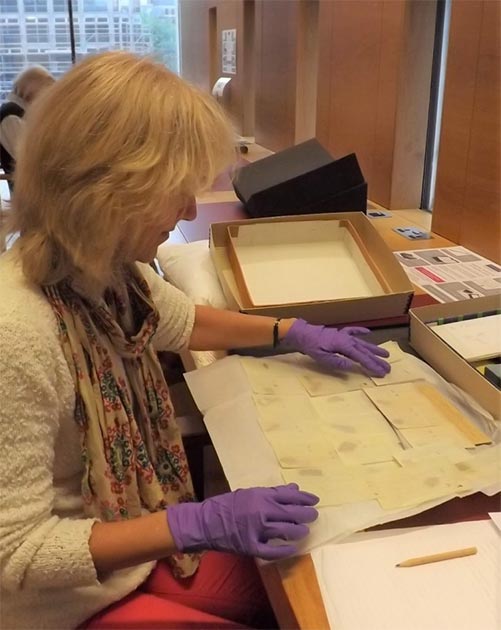
‘Blank’ Dead Sea Scroll Fragments Reveal Hidden Message
A team of experts have made an important discovery about some Dead Sea Scroll fragments in the United Kingdom. They have found letters on four fragments that were believed to be ‘blanks’. This finding could help researchers to revisit other fragments of the texts and help them to better understand the enigmatic Dead Sea Scrolls and to fight against forgeries.
The Dead Sea Scrolls were found in the Qumran Caves, east of Jerusalem on the West Bank, in 1948, when the area was governed by Jordan. A Bedouin found the large body of scroll parchments in the cave, not far from the northern shore of the Dead Sea, after which the collection is named. Many of the texts are over 2000 years old, and include some incomplete books from the Old Testament and some other religious writings.

The Qumran Caves where the Dead Sea Scroll fragments were found in 1948. (alon / Adobe stock)
It is believed that they were produced by the mysterious Jewish sect known as the Essenes, who possibly hid the scrolls in the cave for safety during the First Jewish Revolt against Rome (66-73 AD) and for an unknown reason never returned. The scrolls have provided many insights into the development of the Bible.
Blank Fragments Deemed Worthless
An international team re-examined a collection of scroll fragments that have been held by the University of Manchester. These were donated to an expert from the University of Leeds by the Jordanian government, who believed that they were blank and therefore worthless. They were deemed perfect for testing, and later they were donated by Leeds to the University of Manchester. They are now held in the John Ryland Library, which is “one of the world’s greatest repositories of Judeo-Christian texts,” according to Professor Christopher Pressler, its director, reports Manchester 1824.
Ancient Words Come to Light
Denis Mizi, from the University of Malta, who took part in the research told The Smithsonian Magazine that “fragments were submitted for destructive analysis, they cut very thin specimens (not larger than a couple of mm) from the existing fragments.” As a result, the fragments were preserved despite being test samples.
These supposedly blank pieces of manuscripts held in Manchester were re-examined to determine if any or part of the scrolls had previously been overlooked or misinterpreted, which was part of the project by the international team.
After a preliminary examination, Professor Joan Taylor, one of the researchers, believed she saw a Hebrew letter. She said, “looking at one of the fragments with a magnifying glass, I thought I saw a small, faded letter - a lamed, the Hebrew letter ‘L’,” according to Manchester 1824. The team then submitted 51 ‘blank’ pieces for multispectral imaging. This allowed them to see things that are not visible to the naked eye. The imaging found some letters on four fragments in total. Prof. Taylor stated that “there are only a few on each fragment, but they are like missing pieces of a jigsaw puzzle you find under a sofa,” reports DQCAAS.

Joan Taylor examining the Dead Sea Scroll fragments in the John Rylands Library Reading Room. (University of Manchester)
One fragment has the remains of a passage of four lines of text. It has about 16 letters and only the word Sabbath is legible. Manchester 1824 reports that this “may be related to the biblical Book of Ezekiel (46:1-3).” The other fragments only contain vestiges of letters, some are Hebrew letters, but others appear to be Aramaic, which was the lingua franca of much of the Levant in the Classical era.
- At Least Five Dead Sea Scroll Fragments at the Museum of the Bible Are Fake
- Skeletons Found Near Dead Sea Scrolls Likely Belonged to an Enigmatic Religious Group
- One of the Last Two Known Dead Sea Scrolls Is Deciphered
Forgeries and Scandals
The fragments are authentic and came from the caves where the Dead Sea Scrolls had been deposited. Many purported fragments of the Jewish sect’s texts around the globe are believed to be forgeries. There is a huge industry dedicated to the forgery of antiquities, especially in the Middle East. Recently the Museum of the Bible in Washington D.C. was rocked when it was revealed that 16 fragments of their Dead Sea Scrolls were actually elaborate forgeries.
Professor Robert Cargill, of the University of Iowa, told The Smithsonian Magazine this study “is a reassuring success story about the use of new technological approaches in archaeology.” This study demonstrates that technology can help us to identify what is a historic treasure and what is a forgery. Research is continuing on the Dead Sea fragments held at the John Rylands Library and the findings are expected to be published in an academic journal in the future.
Top image: The Dead Sea Scroll fragments, which originally were believed to be blank, but now new research has revealed ancient writing. Source: University of Manchester
By Ed Whelan















